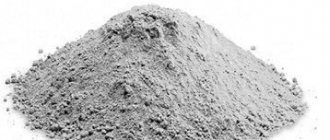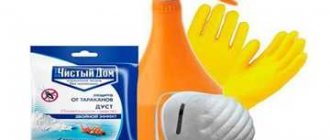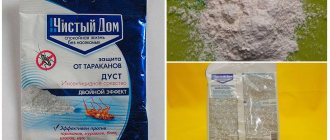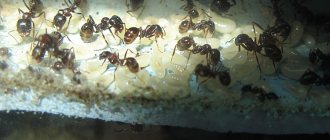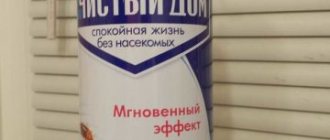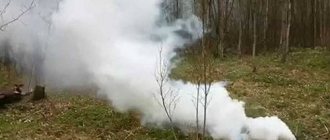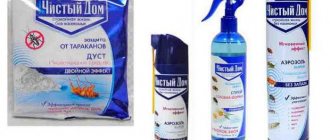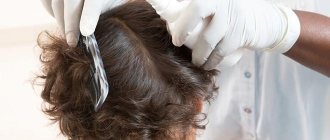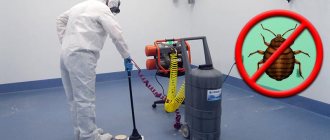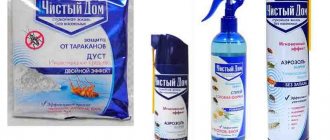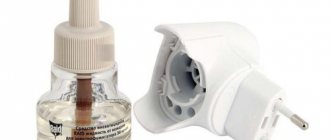The product allows you to quickly and effectively deal with insects that have come into your home without an invitation. The main advantage is that the spray is odorless, so it can be used both at home and at work. The manufacturing company also produces a powerful dust that also easily copes with insects.
Both insecticides are convenient and equally effective against all types of insects, but most modern buyers give their preference to the aerosol.
The instant spray is effective against both flying and non-flying insects. With its help, you can quickly get rid of pests that have invaded your territory. You can buy Clean Home aerosol at an attractive price on our official website.
Spray "Clean House" against bedbugs
Bed bugs have been preventing people from sleeping well for thousands of years, but in the 1950s they were finally eradicated by the pesticide DDT and it was banned then, but for the better part of 40 years since then, bed bugs have not been a major problem.
Recently, these blood-sucking parasites have returned and attacked people with a vengeance. It is bad news.
The good news is that, unlike mosquitoes and ticks, bed bugs do not spread disease, and there are new modern insecticides you can apply to extinguish and prevent infestations. And if you have bed bugs, you can get rid of them yourself. We'll tell you how to get rid of bed bugs using Clean Home products if you find them, and how to never let them into your home again.
Useful materials
Read other articles about cockroaches:
- To successfully combat these parasites, you need to know where they come from in your apartment, what they eat? What is their life cycle and how do they reproduce?
- The most common types here are red and black. How are they different and what to do if you see a white cockroach in your apartment?
- Interesting facts: what nicknames did people come up with for these insects; did you know that there are flying species; some myths about where the mustachios disappeared and what it could mean?
- Can cockroaches cause physical harm to humans, such as biting or getting into the ear and nose?
- A detailed article about how to get rid of them, the most effective methods of control and prevention.
- There are now many treatments on the market against these parasites. Therefore, we wrote an article about how to choose a drug that is right for you, described the best products available today, and compiled a rating of insect repellent drug manufacturers.
- And of course, we couldn’t ignore all sorts of folk methods, in particular the most popular is boric acid.
- Well, if you yourself cannot cope with uninvited guests, then we recommend turning to professionals. They have modern fighting technologies and will save you from misfortune once and for all.
- Find out if electronic repellers help?
- Means that have proven themselves against these parasites: powders and dusts, crayons and pencils, traps, gels, aerosols.
If you find an error, please select a piece of text and press Ctrl+Enter.
Composition of the product and principle of its action
Cypermethrin is a synthetic pyrethroid insecticide used to kill insects in fields and gardens and to kill bed bugs, cockroaches, fleas and termites in homes and other buildings. Cypermethrin is toxic to the nervous system of insects. It works by attacking the nervous system of bed bugs and other insects, killing through paralysis.
All products from the “Clean Home” series are lethal to bed bugs. You need to find bedbug nests. It may be better to kill the eggs using other means because Clean House products are more focused on adult bed bugs.
Cypermethrin is an analogue of a natural substance that is naturally found in chrysanthemum flowers. The reason why it is preferred over natural ones is that once sprayed, it lasts for up to a month. Natural substances decompose within a few hours of exposure to oxygen and light.
Cypermethrin has low toxicity to humans and is safe for use around pets when used as directed. Because it is a synthetic pyrethroid, it lasts longer than natural pyrethrum and provides long-lasting control and prevention of bed bugs.
Localization of processing
| Pest | Places of application |
| cockroaches | under walls, baseboards, pipes, in all crevices, vents, under sinks, bathtubs, next to trash cans, behind carpets, behind and under furniture and appliances |
| flies | in places where garbage accumulates, window and door openings, outside the room |
| fleas | cracks, floor coverings, especially from the inside, walls up to 1 m from the floor |
| fabric bugs | all upholstered furniture inside and out, mattresses, carpets on both sides (wash bed linen at the highest possible temperature, iron with a hot iron) (treat blankets and pillows with live steam, send them for industrial washing, be sure to ventilate and dry in direct sunlight) |
| ants | “paths”, burrows, where bait is placed (drops of syrup) |
Forms of release of the product
The range of products from the Clean House brand against bedbugs is presented in the form of powder, aerosol, chalk and spray. All of them are made taking into account the latest achievements of science, and timely and correct application will allow you to get rid of bed bugs in a short time. You can buy any drug for removing bedbugs at an affordable price.
Powder
Powder under the brand “Clean House” for bedbugs is, in fact, a dust well known to our grandmothers. Contains insecticides tetramethrin, cypermethrin, as well as piperonyl butoxide, which increases the toxicity of the drug several times. All this makes the use of powder problematic in homes with small children and pets.
You can use Clean House powder for bedbugs in two ways:
- Make the solution according to the instructions and treat cracks, crevices, furniture backs, carpets and other places where bed bugs like to hide during the day.
- Sprinkle a thin layer of Clean House powder in areas where bedbugs might travel.
IMPORTANT!!! After a few hours, the room should be ventilated and thoroughly cleaned to avoid poisoning.
Aerosol
Aerosol bed bug killer, from the “Clean House” series of insecticides, is a completely ready-to-use insecticide that leaves no traces on treated surfaces. It is believed that due to its low toxicity, the “Clean House” remedy for bedbugs does not pose a great danger to people. Thanks to its wide spectrum of action, the Clean House spray is used to combat various creeping and flying pests.
The “Clean House” composition against bedbugs contains effective poisonous ingredients - cypermethrin and tetramethrin. They have a neuroparalytic effect on the body of bed bugs. The substances complement each other and enhance the damaging effect on insects.
Chalk
The “Clean House” chalk against bedbugs can be a good helper in the fight against household pests. It is easy to use, economical and affordable. The “Clean House” insecticide is available in pencil form. Draw stripes along the likely path of bed bugs.
The width of the stripes must be at least 4 centimeters. One “Clean House” chalk is enough to treat surfaces over an area of about 20 square meters. m. Its convenience is that you can draw to block the paths of bedbugs, drawing their defensive lines at all levels.
“Clean House” chalk against bedbugs contains the toxic substance alpha-cypermethrin, so it should be stored in places inaccessible to pets and children.
Spray
The “Clean House” spray against bedbugs is similar in composition to the “Clean House” aerosol, but it contains one more component - piperonyl butoxide. Strengthens the damaging effect of the drug and contributes to its high effectiveness. Marketers present this as an advantage over other means of removing bedbugs. The “Clean House” preparation can be used to treat upholstered furniture, as it does not leave marks on the fabric.
There is no unpleasant odor after spraying. It is believed that short-term ventilation of the room after the procedure for exterminating bedbugs eliminates all the consequences of this event. I would like to draw your attention to the fact that the world has not yet invented magic sprays that are guaranteed to kill all bed bugs. Clean House Bed Bug Spray, like most other insecticides, kills bed bugs when sprayed carefully and directly onto the insects and doused with a detergent.
Gel
The Clean House gel is not suitable for bed bugs, although it also contains strong insecticides. The principle of action involves insects eating tasty poison. But bedbugs only eat human blood.
Gel "Clean House" works well in the fight against cockroaches and house ants. Particles of poison are carried on the paws of pests. A stable result is guaranteed by the long-lasting action of the gel. The Clean Home product is available in convenient tubes or syringes. This form of packaging makes it easier to apply the substance even in hard-to-reach places.
Danger and contraindications
Modern manufacturers are increasingly beginning to pay attention to these 2 factors. Safety comes first. The concentration in the can is such that it is sufficient to kill insects, but does not cause harm to human health when used correctly. Aerosol Clean House belongs to hazard class 4. In case of contact with the skin it can cause irritation, in the respiratory tract - coughing, sneezing, in the stomach - nausea, weakness, malaise. It is not recommended to carry out treatment for people prone to allergies, with respiratory diseases and asthma patients.
When working with aerosol, you must protect your hands with rubber gloves and your respiratory tract with a mask or respirator. Wear a suit that will protect your entire body. When using the powder, it is enough to use gloves and a gauze bandage. Animals must be removed from the premises during processing.
Impact on human health
The manufacturer claims that the concentration of pitethroids included in the “Clean House” line of products against bedbugs is safe for humans. However, it would be useful to know how pyrethroids affect humans.
The use of pyrethroids, especially in confined spaces, is considered dangerous. Claims on packaging that a product is regulatory approved and safe do not actually provide protection against health hazards.
The effect of so-called decontamination measures is questionable, since the active ingredients of the drugs used are deposited on all surfaces (walls, floors, furniture) and are slowly released into the room.
Due to the very large surface area of house dust, pyrethroids are also deposited directly into it to a certain extent. Some pyrethroids can cause very serious health problems.
Primary pyrethroids act as neurotoxins. In large doses, it can lead to seizures, paralysis or hyperexcitability. Since consumption occurs primarily through dust, skin allergies as well as eye and upper respiratory tract irritation may occur. Paresthesias such as tingling, numbness and dizziness are caused by symptoms of long-term effects.
The effect of nerve damage must be classified as particularly important because some researchers suggest that nerve damage is irreversible and the effects of individual pyrethroids are additive. This means that the gradual absorption of individual pyrethroids (for example, from carpets), as a long-term consequence of pest control, will at some point in the future reach a high level of poison concentration in the body of people living in the apartment. There are opinions that the toxicity of pyrethroids should be rated higher due to the additive effect and its high stability.
Since there is not enough information about the "harmless" amount of pyrethroids and their synergists, according to some doctors and toxicologists, health problems are already caused by much ultra-low levels of pyrethroid in dust, especially in children.
When working with these products, you must take all safety precautions as much as possible. Cypermethrin, which is included in all Clean House products, is classified as a possible human carcinogen because it causes an increase in the incidence of lung tumors in female mice. Cypermethrin has been associated with an increase in bone marrow micronuclei in both mice and humans.
More about tetramethrin
Tetramethrin was first used as an insecticide in 1968. This fast working contact insecticide is used to target a range of flying and crawling insect species. Tetramethrin hyperactivates nerve cells, ultimately leading to paralysis and death of insects. The substance is used primarily in commercial outdoor pest control products, although it is also used indoors in residential areas.
Tetramethrin is metabolized quickly, so there is little risk to human health at relatively small exposure levels. Contact with skin may cause irritation and may cause shortness of breath if inhaled. Tetramethrin is not registered for any use on any crops, so not much is known about it in this area. Tetramethrin is highly toxic to bees, fish, amphibians, and aquatic invertebrates, so when treating residential premises these living creatures should not be present there.
Precautionary measures
Expert opinions on the dangers of pyrethroids are highly controversial. I would like to note that this chapter is not intended to intimidate you when using products from the “Clean Home” line, but refers to the general rules for using products that contain pesticides.
To completely protect yourself from possible negative consequences, you can measure pyrethroids in your apartment. These low-volatile substances cannot be detected independently because they are present only in minute traces of indoor air. However, they bind to dust and surfaces due to their high lipid solubility (lipophilicity). Therefore, increases in pyrethroid concentrations cannot be adequately monitored by measuring indoor air. You will need to submit a sample of house dust for analysis, which can be collected using a regular vacuum cleaner. For a more accurate assessment, it is useful if the dust comes from different rooms. If possible, you should check the dust that has accumulated for a period of 1 to 2 weeks after treating the apartment with insecticides.
Instructions for use
Regarding application, it is worth noting that since this product is an aerosol, due to its spraying, harmful substances can get onto the products. In this regard, before starting the procedure, it is necessary to hide food, hermetically separating it from the external environment, for example, in the refrigerator or on the balcony.
Pets need to be “evicted” from the apartment and returned to their permanent place of residence after a certain time has passed after treatment.
Proper cleaning from cockroaches involves the use of protective equipment: at a minimum, rubber gloves and a respirator. To avoid contact of poison with the skin, carry out the procedure in clothes with long sleeves.
After careful preparation, you can begin the procedure for eviction of unwanted roommates. The product needs to be shaken and the room treated with it, paying special attention to cracks, ventilation, and the area around the trash can. It is recommended to use the gel for treating skirting boards.
Before the procedure, you need to close the vents, doors and windows and leave the apartment for a couple of hours.
Upon returning home, it is worth ventilating the room, washing the treated areas and getting rid of dead insects.
So, “Clean House” is an effective anti-cockroach drug that does not have a prolonged effect. Therefore, to completely get rid of insects, other means are used in parallel, in particular, a trap and gel.
How to clean an apartment after using pesticides?
In this article, we have fully described which pesticides are included in each product in the Clean House line of bed bug exterminators, but if you use other chemical insect exterminators, it will be useful for you to familiarize yourself with the tips below.
If you don't know what pesticides were used, start by looking at the ingredients on the product label. Understand what ingredients are in your home and how they interact with your carpets, linoleum, or woodwork.
Until you know what pesticides were used, do not attempt any cleaning method without consulting a professional. Some pesticides can react poorly with acids, and some pesticides even react with water. Try to obtain technical advice and evaluation for the specific product, including toxicity and persistence.
There are no standard cleaning procedures for removing unwanted pesticide residues and there are many potential hazards to avoid. Consider hiring a professional to clean your home, especially if you have misused or overused pesticides in your home.
Most common use
Tetramethrin is an insecticide that is often used on target insects such as wasps, hornets, cockroaches, ants, fleas and mosquitoes. Today there are commercial products that can also be used against bedbugs. Tetramethrin is often combined with another active ingredient for broader control, such as cypermethrin.
Tetramethrin in commercial products has a wide range of household applications, including general surface and air sprays that can be used on a variety of surfaces, including indoor and outdoor plant leaves, clothing, bedding, indoors, and direct application to pets. . However, contact of the substance with human skin is not recommended, since the substance is quickly absorbed into the inner layers of the skin and causes irritation.
How do you know if a thorough tidy is needed?
After you use one or another product from the “Clean House” series, you will have to think about cleaning your apartment. Especially if you have treated your carpets and upholstered furniture with Clean House spray.
There is no simple set of rules that can determine whether or not your home needs to be cleaned, or how or what needs to be cleaned. A professional can help you identify your underlying problems and assess the level of contamination in your home. Pesticides are common in homes, even without a history of misuse.
If you have not used Clean Home products, but some other product, then before seeking advice, you should know the answers to all the questions below:
- What product was used?
- How exactly was the product diluted?
- Which rooms were treated?
- Have the voids on the walls been treated?
- How much product was used in total?
How do you know which objects and surfaces are contaminated with pesticides?
Although the products produced under the “Clean House” brand are intended for household and not professional use, it is still better for you to remember the popular proverb: “God protects those who are careful” and study our recommendations with maximum attention.
Collect as much information as possible about where the pesticide was applied. For example, if it was applied to cracks and cracks, it is important to understand at what height of the walls and what area of the floor were treated.
It is very difficult to say how much pesticides can negatively affect health. This depends on the toxicity of the chemical(s) used, the frequency of contact with contaminated surfaces, the likelihood of the chemical escaping into the breathing air, the sensitivities and habits of the occupants, and other factors. You can consult with an industrial hygienist who can help you make an informed decision about whether cleaning is necessary.
If you want to perform any kind of laboratory analysis, ask if the results will be interpreted in detail and clearly so you can understand. Some laboratories offer analytical services without extensive commentary, leaving people to guess the meaning of the test results. Which materials should be thrown away and which can be cleaned up?
What should you throw out of your home?
It is possible that using the Clean House spray will require you to throw away some items that have come into contact with the liquid.
Porous materials can absorb liquids and possibly dust, drawing them deep inside. Non-porous materials do not allow liquids or dust to penetrate their surfaces, making them much easier to clean. This is what you need to be guided by when determining how to clean or discard items.
It may not be possible to remove sufficient pesticide residue from porous and semi-porous items. For example, one study found that washing linoleum twice with detergent followed by rinsing had no effect on pesticide residue levels.
To protect yourself and others, consider the following tips:
- Do not dry contaminated items.
- If clothing has been contaminated with pesticide, it should be thrown away.
- Do not use a professional carpet cleaner without consulting a professional.
- Do not use washing machines without consulting a specialist; you can contaminate all your clothes with pesticides.
- Avoid cleaning activities that involve heat unless directed by an expert. When chemicals heat up, they are more likely to be released into the air. Several pesticides can be converted into more toxic chemicals when heated.
- While non-porous items are easiest to clean, some residue may remain. If items are frequently handled by sensitive people such as children (eg, toys and bottles) and the elderly (eg, medical equipment), there is a potential for ongoing exposure. Depending on the situation, some items may be thrown away.
- Sealants can reduce the spread of some pesticides from contaminated surfaces. However, they may not be suitable for all surfaces. A professional can help you make an informed decision. If you use sealant, follow the manufacturer's instructions.
- It is advisable to follow the pesticide manufacturer's recommended strategy for subsequent cleaning of the apartment. Only they know how best to remove pesticide residues.
How to dispose of thrown away items and where to drain the water after cleaning?
After you use Clean House products, you don’t have to throw away all the items you used to clean up your home. But if in the process you did not use the household series of drugs for exterminating bed bugs “Clean House”, but professional means to combat bed bugs, then you should think about the following.
If you hire a company, they should manage the disposal. If not, you should find out the answers to the questions:
- Should mop pads go in the trash?
- Where to pour contaminated water after washing the floor?
- Is it appropriate to wash lightly soiled items?
Can I use bleach?
When you start cleaning your apartment after removing bedbugs using products from the “Clean House” series, pay attention to the information below.
Bleach may react with some pesticide chemicals. Reactions may result in more toxic chemicals, unexpected fumes, or other problems. If you have identified the specific product in question, ask the product manufacturer if bleach or detergent is recommended. Without proper information, avoid using bleach. Products containing sodium hypochlorite are bleaches.
Flaws
The main disadvantage is that the product does not act on the larvae that are in the ooteca. And also those individuals who were able to hide in hard-to-reach places. Weak prolonged action. However, the problem can be solved quickly - by using aerosol and cockroach powder together.
It should be borne in mind that without compliance with preventive measures, any drug will not give the desired result. And if a multi-storey building is severely infested, it is necessary to contact specialists.
How to use ventilation?
If the pesticide is dusty or may produce dust, try to minimize air movement. Turn off ventilation systems and close windows. Dry dust can be cleaned using wet methods to reduce its release into the air. However, adding moisture can cause chemical reactions. Consult a professional before getting wet with pesticide dust.
If the pesticide is a liquid, ventilation will be helpful. As air passes through the structure to the outside, there will be chemicals present in the air. In our case, if the drug of choice is the “Clean House” spray, ventilation will be a good addition to completing the tidying of the house.
Is personal protective equipment such as gloves and safety glasses required?
Not all products under the Clean House brand require personal protection. You can use chalk without wearing a mask and rubber gloves, but still, any handling of chemicals, even if they are household chemicals, is better to take care of yourself and protect yourself from accidental contact of the product with the skin or from inhaling fumes containing toxic agents.
If a specific product can be identified, read the product label and safety data sheet provided by the manufacturer. They will determine the type of equipment needed to apply or process the product. These instructions are based on the manufacturer's unique knowledge of the product. If the exact product cannot be identified, do not guess or rely on a simple internet search. Dozens of products may have the same name, but they may have different ingredients and require different personal protective equipment (e.g. gloves, safety glasses, etc.).
If the pesticide was applied as dust, consider using a mask designed for fine particles rather than evaporation. Safety glasses that fit tightly against your skin will prevent dust from irritating your eyes. Shoe covers can be useful, especially if the shoes have laces or fabrics that can trap dust.
If the pesticide was applied as a liquid, consider using a mask designed for organic vapors and fine particles. Protect your skin from contact with liquids used during the cleaning process. Avoid using gloves made of any porous material such as leather or fabric.
Barrier laminated gloves are highly resistant to chemicals in all eight chemical resistance categories. However, even high-strength materials will not provide unlimited protection. They need to be replaced or cleaned and rinsed during breaks. Other materials with lower levels of chemical resistance must be cleaned or replaced after every 10 to 60 minutes of contact.
Preparing for disinfestation
Although Clean House preparations belong to hazard classes 3 (moderately dangerous) and 4 (low-hazardous), in fact they are poison and the use of personal protective equipment is mandatory. Goggles, gloves, a respirator and a change of clothes will not hurt. Before you begin, you should carry out some preparatory activities:
- Clear your apartment of people and pets
- If you have indoor flowers and an aquarium, take them out or cover them tightly
- Move all furniture to the middle of the room so that there is access to the baseboards around the perimeter
- Take down the curtains
- Remove carpets, paintings and all decorative elements from the walls
- Clean with a vacuum cleaner and a wet cloth; this will help you partially destroy any insects encountered, detect nests and determine the extent of infestation.
- Put all dishes in cabinets
- Pack food, cosmetics, personal hygiene products in sealed bags
- Put the clothes in the closet, making sure in advance that it does not need to be processed
